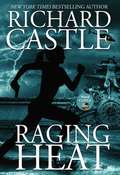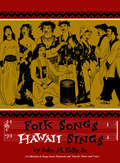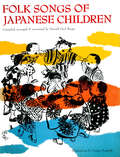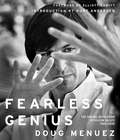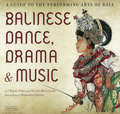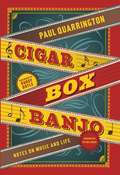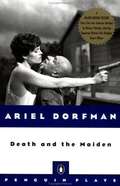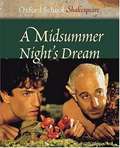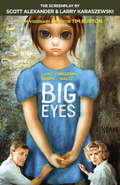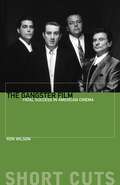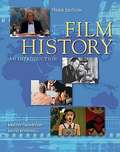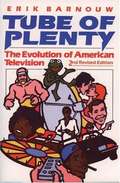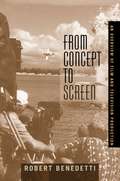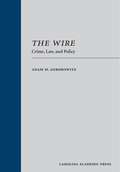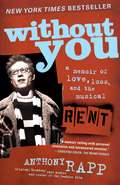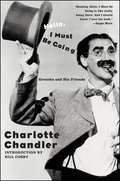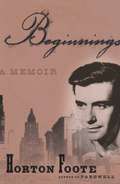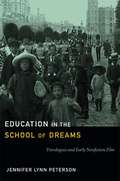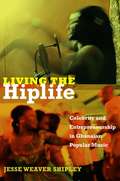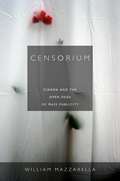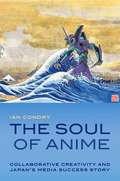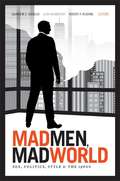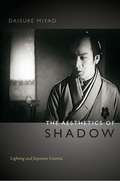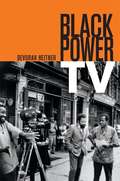- Table View
- List View
Raging Heat (Nikki Heat #6)
by Richard CastleIn New York Times Bestselling author Richard Castle's newest novel, an illegal immigrant falls from the sky and NYPD Homicide Detective Nikki Heat's investigation into his death quickly captures the imagination of her boyfriend the Pulitzer Prize-winning journalist, Jameson Rook. When he decides to work the case with Heat as his next big story, Nikki is at first happy to have him ride along. Yes, she must endure Rook's usual wild conspiracy speculations and adolescent wisecracks, but after reuniting following his recent assignment abroad, she's glad for the entertainment, the chance to bounce ideas, and just to be close to him again and feel the old spark rekindle. But when Rook's inquiry concludes that Detective Heat has arrested the wrong man for the murder, everything changes. <P> Balancing her high stakes job with a complicated romance has been a challenge ever since Nikki fell for the famous reporter. Now, her relationship lurches from mere complexity into sharp conflict over the most high-risk case of her career. Set against the raging force of Hurricane Sandy as it pounds New York, Heat battles an ambitious powerbroker, fights a platoon of urban mercenaries, and clashes with the man she loves. Detective Heat knows her job is to solve murders. She just worries that solving this one will be the death of her relationship.
Folk Songs Hawaii Sings
by John M. KellyFolk Songs Hawaii Sings is a sparkling compilation of melodies from the islands of Polynesia together with a variety of folk songs that countless Oriental people have brought with them to their new home in the Hawaiian Islands. In one sense it is a musical picture of the renowned harmonious blend of people who reside in Hawaii today; in another, it is a colorful record of ties with the Eastern world and ancestral heritage in line with the same American tradition that saw songs of the soil and the sea brought to the United States from Europe in an earlier age.All the songs and more, whether from Hawaii or Samoa, China or Japan, the Philippines, Okinawa, or Mongolia, are melodic bearers of traditions and aspirations, or vehicles of simple pleasures that form the background of the people who today share the hospitable sun of the Hawaiian Islands with their Caucasian neighbors. These melodies and rhythms have found their way into the many festivals and musical presentations that are so much a way of life in the welcome addition to the American Union.
Folk Songs of Japanese Children
by Yoshie Noguchi Donald Paul BergerSimple, singable, and engaging, the traditional songs of Japanese children combine the unique charm of Japan with the universal appeal of children's music everywhere. Some of the fifteen songs in this collection are current throughout Japan. Others are little known outside a small area. All have deep roots in history and tradition. Several are game songs that will be enjoyed by all children who have played "London Bridge is Falling Down" or "The Farmer in the Dell." Mr. Berger's commentary on each song illuminates many facets of Japanese culture; and his arrangements, with easy piano accompaniments, make the songs suitable for unison or two-part singing by children or adults. The complete Japanese text, in both Japanese characters and Roman alphabet, is included for each song, together with a singable English version and a literal translation.
Fearless Genius
by Kurt Andersen Elliot Erwitt Doug MenuezAn eye-opening chronicle of the Silicon Valley technology boom, capturing key moments in the careers of Steve Jobs and more than seventy other leading innovators as they created today's digital world In the spring of 1985, a technological revolution was under way in Silicon Valley, and documentary photographer Doug Menuez was there in search of a story--something big. At the same time, Steve Jobs was being forced out of his beloved Apple and starting over with a new company, NeXT Computer. His goal was to build a supercomputer with the power to transform education. Menuez had found his story: he proposed to photograph Jobs and his extraordinary team as they built this new computer, from conception to product launch. In an amazing act of trust, Jobs granted Menuez unlimited access to the company, and, for the next three years, Menuez was able to get on film the spirit and substance of innovation through the day-to-day actions of the world's top technology guru. From there, the project expanded to include the most trailblazing companies in Silicon Valley, all of which granted Menuez the same complete access that Jobs had. Menuez photographed behind the scenes with John Warnock at Adobe, John Sculley at Apple, Bill Gates at Microsoft, John Doerr at Kleiner Perkins, Bill Joy at Sun Microsystems, Gordon Moore and Andy Grove at Intel, Marc Andreessen at Netscape, and more than seventy other leading companies and innovators. It would be fifteen years before Menuez stopped taking pictures, just as the dotcom bubble burst. An extraordinary era was coming to its close. With his singular behind-the-scenes access to these notoriously insular companies, Menuez was present for moments of heartbreaking failure and unexpected success, moments that made history, and moments that revealed the everyday lives of the individuals who made it happen. This period of rapid, radical change would affect almost every aspect of our culture and our lives in ways both large and small and would also create more jobs and wealth than any other time in human history. And Doug Menuez was there, a witness to a revolution. In more than a hundred photographs and accompanying commentary, Fearless Genius captures the human face of innovation and shows what it takes to transform powerful ideas into reality.
Balinese Dance, Drama & Music
by Rucina Ballinger I Wayan Dibia Barbara AnelloThis book is a lavishly illustrated introduction to the most commonly seen forms of traditional performing arts in Bali; gamelan music, dance, drama and puppetry. Ideal reading for visitors to the island as well as for anyone interested in Balinese culture. The book presents the history and function of each type of performance with illustrations and photographs to aid in identification. Introductory sections discuss the way performing arts are learned in Bali and the principal Balinese values that are passed on in these forms, as well as some of the basic religious and cultural tenets that are expressed in the arts and the functions of the forms themselves.This book is enhanced with a bibliography and discography and over 200 photographs and specially prepared watercolors of Balinese performances.
Cigar Box Banjo
by Roddy Doyle Paul QuarringtonThis eclectic, funny, and moving book tracks a life lived in music and words. Paul Quarrington ruminates on the bands of his childhood; his restless youth, spent playing bass with the cult band Joe Hall and the Continental Drift; and his incarnation, in middle age, as rhythm guitarist and singer with the band Porkbelly Futures.Ranging through rock 'n' roll, the blues, folk, country and soul, he explores how songs are made, how they work, and why they affect us so deeply. This is also a book about friendship. In his imitably entertaining way, Quarrington recounts the adventures and vicissitudes he and his fellow band members share as they cope with everything from broken strings to broken marriages, making a last stab at that elusive thing called success.
Death And The Maiden
by Ariel DorfmanAriel Dorfman's explosively provocative, award-winning drama is set in a country that has only recently returned to democracy. Gerardo Escobar has just been chosen to head the commission that will investigate the crimes of the old regime when his car breaks down and he is picked up by the humane doctor Roberto Miranda. But in the voice of this good Samaritan, Gerardo's wife, Paulina Salas, thinks she recognizes another man--the one who raped and tortured her as she lay blindfolded in a military detention center years before.
A Midsummer Night's Dream
by William Shakespeare Roma GillFairy and human worlds collide in Shakespeare's beloved comedy of love and error. Includes notes on vocabulary, history and the dramatic structure of the play.
Big Eyes
by Tyler Stallings Larry Karaszewski Scott AlexanderWITH AN INTERVIEW WITH MARGARET KEANEThe full screenplay by award-winning Ed Wood writers Scott Alexander and Larry Karaszewski for acclaimed director Tim Burton's film Big Eyes, starring Amy Adams and Christoph Waltz.A rare close-up look into a corner of the 1950s and '60s art world and a perfectly observed account of a dysfunctional marriage, Big Eyes tells the true story of Margaret Keane, an artist who lived and worked in virtual slavery while her husband, Walter, gained fame and fortune passing himself off as the creator of his wife's wildly popular paintings. The story of their toxic relationship would culminate in a Hawaiian courtroom, as Margaret ultimately fights to save her name and reclaim her art, during a heated public court battle. This edition, illustrated with photos throughout, contains the complete screenplay, an afterword by the screenwriters, and an interview with Margaret Keane, the real-life subject of Big Eyes, by Tyler Stallings.
The Gangster Film: Fatal Success in American Cinema
by Ron WilsonExamines the gangster film in its historical context with an emphasis on the ways the image of the gangster has adapted and changed
Film History: An Introduction, 3rd Edition
by Kristin Thompson David BordwellWritten by two of the leading scholars in film studies, Film History: An Introduction is a comprehensive, global survey of the medium that covers the development of every genre in film, from drama and comedy to documentary and experimental. As with the authors' bestselling Film Art: An Introduction (now in its eighth edition), concepts and events are illustrated with frame enlargements taken from the original sources, giving students more realistic points of reference than competing books that rely on publicity stills. The third edition of Film History is thoroughly updated and includes the first comprehensive overviews of the impact of globalization and digital technology on the cinema. Any serious film scholar--professor, undergraduate, or graduate student--will want to read and keep Film History. Visit the author's blog at http://www. davidbordwell. net/blog/
Tube of Plenty: The Evolution of American Television
by Erik BarnouwBased on the classic History of Broadcasting in the United States, Tube of Plenty represents the fruit of several decades' labor. When Erik Barnouw - premier chronicler of American broadcasting and a participant in the industry for fifty years - first undertook the project of recording its history, many viewed it as a light-weight literary task concerned mainly with "entertainment" trivia. Indeed, trivia such as that found in quiz programs do appear in the book, but Barnouw views themas part of a complex social tapestry that increasingly defines our era. To understand our century, we must fully comprehend the evolution of television and its newest extraordinary offshoots. With this fact in mind, Barnouw's new edition of Tube of Plenty explores the development and impact of the latest dramatic phases of the communications revolution. Since the first publication of this invaluable history of television and how it has shaped, and been shaped by, American cultureand society, many significant changes have occurred. Assessing the importance of these developments in a new chapter, Barnouw specifically covers the decline of the three major networks, the expansion of cable and satellite television and film channels such as HBO (Home Box Office), the success of channels catering to special audiences such as ESPN (Entertainment and Sports Programming Network) and MTV (Music Television), and the arrival of VCRs in America's living rooms. He also includes an appendix entitled "questions for a new millennium," which will challenge readers not only to examine the shape of television today, but also to envision its future.
From Concept to Screen: An Overview of Film and Television Production
by Robert L. BenedettiWritten by an Emmy-award-winning producer and director, this book focuses on the underlying principles of film and television production, emphasizing the creative rather than the technical aspects. The book describes how a film is created - from conception to screen - and provides a comprehensive overview of the entire production process. Not intended as a "how-to" book, this book presents only a limited amount of detailed technical information. Instead, it emphasizes the underlying principles and processes of primarily four kinds of films: feature, independently financed, made-for-network-television, and made-for-cable movies. For anyone interested in writing, directing, producing or acting for film/TV.
The Wire: Crime, Law, and Policy
by Adam M. GershowitzThe HBO series, The Wire, provides a springboard for discussing some of the most pressing criminal justice issues of our time. This book explores the law of wiretapping, drug possession, and sentencing. It considers questions beyond basic law, such as whether the police understand or follow the Supreme Court's search and seizure and confession rules. The book also examines broader questions, such as crime statistic manipulation, drug legalization, prisoner reentry, police brutality, the use of informants, mass imprisonment of African Americans, the distribution of limited criminal justice resources, and the media's influence on policing and public policy.
Without You
by Anthony RappAnthony Rapp captures the passion and grit unique to the theatre world as he recounts his life-changing experience in the original cast of the Pulitzer Prize-winning musical Rent. Anthony had a special feeling about Jonathan Larson's rock musical from his first audition, so he was thrilled when he landed a starring role as the filmmaker Mark Cohen. With his mom's cancer in remission and a reason to quit his newly acquired job at Starbucks, his life was looking up. When Rent opened to thunderous acclaim off Broadway, Rapp and his fellow cast members knew that something truly extraordinary had taken shape. But even as friends and family were celebrating the show's success, they were also mourning Jonathan Larson's sudden death from an aortic aneurysm. By the time Rent made its triumphant jump to Broadway, Larson had posthumously won the 1996 Pulitzer Prize. When Anthony's mom began to lose her battle with cancer, he struggled to balance the demands of life in the theatre with his responsibility to his family. Here, Anthony recounts the show's magnificent success and his overwhelming loss. He also shares his first experiences discovering his sexuality, the tension it created with his mother, and his struggle into adulthood to gain her acceptance. Variously marked by fledgling love and devastating loss, piercing frustration and powerful enlightenment, Without You charts the course of Rapp's exhilarating journey with the cast and crew of Rent as well as the intimacies of his personal life behind the curtain.
Hello, I Must Be Going
by Charlotte ChandlerWhen Charlotte Chandler called Groucho Marx for an interview, he answered the phone himself. Declining to be interviewed, he invited her over to his house so he could tell her no in person. After talking with her for hours, Groucho asked, "Why aren't you writing?" Hello, I Must Be Going is the story of Groucho and the Marx Brothers, told through Groucho's everyday conversations with Charlotte Chandler and his friends. And what a group of friends they were! Woody Allen, Jack Nicholson, Elliott Gould, Bill Cosby, Marvin Hamlisch, Betty Comden, Adolph Green, Sidney Sheldon, and dozens of others walk through the pages of this fascinating book. Anyone interested in Groucho or the Marx Brothers, or who wants to spend a few hours in fabulous company, will find this book irresistible.
A Deed of Death: The Story Behind the Unsolved Murder of Hollywood Director William Desmond Taylor
by Robert GirouxWell-born but disinherited Anglo-Irish actor and one-time Yukon prospector, William Desmond Taylor was a prominent Paramount movie director at the time of his unsolved murder in 1922. Suspects included his secretary Edward Sands, a thief and forger; Henry Peavey, his homosexual black cook; and two flamboyant screen stars: drug-addicted Mabel Normand, whom he loved; and 20-year-old Mary Miles Minter, who yearned to be his mistress. In a meticulous probe that reads like a detective thriller, editor-publisher Giroux ( The Book Known as Q ) makes a strong case that the murderer was a contract killer. He shows that Normand had incurred the wrath of dope peddlers, as did Taylor when he attempted to help her break her addiction. Brimming with details of Hollywood's silent era and its rampant post-WW I drug culture, this procedural offers glimpses of Mary Pickford, Charlie Chaplin, Sam Goldwyn, Mack Sennett, Fatty Arbuckle. Illustrations. Copyright 1990 Reed Business Information, Inc.
Beginnings
by Horton FooteSince 1939, Horton Foote, "the Chekhov of the small town," has chronicled with compassion and acuity the experience of American life both intimate and universal. His adaptation of Harper Lee's To Kill a Mockingbird and his original screenplay Tender Mercies earned him Academy Awards. He has won a Pulitzer Prize, the Gold Medal for Drama from the American Academy of Arts and Letters, the PEN/Laura Pels Foundation Award for Drama, and the President's National Medal of Arts. Beginnings is the story of Foote's discovery of his own vocation. He didn't always want to write. When he left Wharton, Texas, at the age of sixteen to study at the Pasadena Playhouse, Foote aspired to be an actor. He remembers the terror and excitement of leaving home during the Depression, his early exposure to the influences of German theater, and the speech lessons he took to "cure" him of his Southern drawl. He eventually arrives in New York to search for acting jobs and to study with some of the great Russian and American teachers of the 1930s. But after mixed results on the stage, he finally recognizes his true passion, writing. From Martha Graham to Tennessee Williams, from Agnes de Mille to Lillian Gish, Horton collaborates with great artists in both dance and theater. The world he describes of fierce commitment and passion regardless of financial rewards is both captivating and inspiring. Through it all Horton maintains his genuine Southern charm, and he often travels home to Wharton, the town that nurtured him as a storyteller and has inspired his writing for the past sixty years. From one of the most moving and distinctive voices of our time, Beginnings is a rare, personal look at a fascinating era in American life, and at the making of a writer.
Education in the School of Dreams: Travelogues and Early Nonfiction Film
by Peterson Jennifer LynnIn the earliest years of cinema, travelogues were a staple of variety film programs in commercial motion picture theaters. These short films, also known as "scenics," depicted tourist destinations and exotic landscapes otherwise inaccessible to most viewers. Scenics were so popular that they were briefly touted as the future of film. But despite their pervasiveness during the early twentieth century, travelogues have been overlooked by film historians and critics. In Education in the School of Dreams, Jennifer Lynn Peterson recovers this lost archive. Through innovative readings of travelogues and other nonfiction films exhibited in the United States between 1907 and 1915, she offers fresh insights into the aesthetic and commercial history of early cinema and provides a new perspective on the intersection of American culture, imperialism, and modernity in the nickelodeon era. Peterson describes the travelogue's characteristic form and style and demonstrates how imperialist ideologies were realized and reshaped through the moving image. She argues that although educational films were intended to legitimate filmgoing for middle-class audiences, travelogues were not simply vehicles for elite ideology. As a form of instructive entertainment, these technological moving landscapes were both formulaic and also wondrous and dreamlike. Considering issues of spectatorship and affect, Peterson argues that scenics produced and disrupted viewers' complacency about their own place in the world.
Living the Hiplife: Celebrity and Entrepreneurship in Ghanaian Popular Music
by Shipley Jesse WeaverHiplife is a popular music genre in Ghana that mixes hip-hop beatmaking and rap with highlife music, proverbial speech, and Akan storytelling. In the 1990s, young Ghanaian musicians were drawn to hip-hop's dual ethos of black masculine empowerment and capitalist success. They made their underground sound mainstream by infusing carefree bravado with traditional respectful oratory and familiar Ghanaian rhythms. Living the Hiplife is an ethnographic account of hiplife in Ghana and its diaspora, based on extensive research among artists and audiences in Accra, Ghana's capital city; New York; and London. Jesse Weaver Shipley examines the production, consumption, and circulation of hiplife music, culture, and fashion in relation to broader cultural and political shifts in neoliberalizing Ghana. Shipley shows how young hiplife musicians produce and transform different kinds of value--aesthetic, moral, linguistic, economic--using music to gain social status and wealth, and to become respectable public figures. In this entrepreneurial age, youth use celebrity as a form of currency, aligning music-making with self-making and aesthetic pleasure with business success. Registering both the globalization of electronic, digital media and the changing nature of African diasporic relations to Africa, hiplife links collective Pan-Africanist visions with individualist aspiration, highlighting the potential and limits of social mobility for African youth. The author has also directed a film entitled Living the Hiplife and with two DJs produced mixtapes that feature the music in the book available for free download.
Censorium: Cinema and the Open Edge of Mass Publicity
by William MazzarellaIn the world of globalized media, provocative images trigger culture wars between traditionalists and cosmopolitans, between censors and defenders of free expression. But are images censored because of what they mean, what they do, or what they might become? And must audiences be protected because of what they understand, what they feel, or what they might imagine? At the intersection of anthropology, media studies, and critical theory, Censorium is a pathbreaking analysis of Indian film censorship. The book encompasses two moments of moral panic: the consolidation of the cinema in the 1910s and 1920s, and the global avalanche of images unleashed by liberalization since the early 1990s. Exploring breaks and continuities in film censorship across colonial and postcolonial moments, William Mazzarella argues that the censors' obsessive focus on the unacceptable content of certain images and the unruly behavior of particular audiences displaces a problem that they constantly confront yet cannot directly acknowledge: the volatile relation between mass affect and collective meaning. Grounded in a close analysis of cinema regulation in the world's largest democracy, Censorium ultimately brings light to the elusive foundations of political and cultural sovereignty in mass-mediated societies.
The Soul of Anime: Collaborative Creativity and Japan's Media Success Story
by Ian CondryIn The Soul of Anime, Ian Condry explores the emergence of anime, Japanese animated film and television, as a global cultural phenomenon. Drawing on ethnographic research, including interviews with artists at some of Tokyo's leading animation studios--such as Madhouse, Gonzo, Aniplex, and Studio Ghibli--Condry discusses how anime's fictional characters and worlds become platforms for collaborative creativity. He argues that the global success of Japanese animation has grown out of a collective social energy that operates across industries--including those that produce film, television, manga (comic books), and toys and other licensed merchandise--and connects fans to the creators of anime. For Condry, this collective social energy is the soul of anime.
Mad Men, Mad World: Sex, Politics, Style, and the 1960s
by Lauren M. E. Goodlad Lilya Kaganovsky Robert A. RushingSince the show's debut in 2007, Mad Men has invited viewers to immerse themselves in the lush period settings, ruthless Madison Avenue advertising culture, and arresting characters at the center of its 1960s fictional world. Mad Men, Mad World is a comprehensive analysis of this groundbreaking TV series. Scholars from across the humanities consider the AMC drama from a fascinating array of perspectives, including fashion, history, architecture, civil rights, feminism, consumerism, art, cinema, and the serial format, as well as through theoretical frames such as critical race theory, gender, queer theory, global studies, and psychoanalysis. In the introduction, the editors explore the show's popularity; its controversial representations of race, class, and gender; its powerful influence on aesthetics and style; and its unique use of period historicism and advertising as a way of speaking to our neoliberal moment. Mad Men, Mad World also includes an interview with Phil Abraham, an award-winning Mad Men director and cinematographer. Taken together, the essays demonstrate that understanding Mad Men means engaging the show not only as a reflection of the 1960s but also as a commentary on the present day. Contributors. Michael Bérubé, Alexander Doty, Lauren M. E. Goodlad, Jim Hansen, Dianne Harris, Lynne Joyrich, Lilya Kaganovsky, Clarence Lang, Caroline Levine, Kent Ono, Dana Polan, Leslie Reagan, Mabel Rosenheck, Robert A. Rushing, Irene Small, Michael Szalay, Jeremy Varon
The Aesthetics of Shadow: Lighting and Japanese Cinema
by Daisuke MiyaoIn this revealing study, Daisuke Miyao explores "the aesthetics of shadow" in Japanese cinema in the first half of the twentieth century. This term, coined by the production designer Yoshino Nobutaka, refers to the perception that shadows add depth and mystery. Miyao analyzes how this notion became naturalized as the representation of beauty in Japanese films, situating Japanese cinema within transnational film history. He examines the significant roles lighting played in distinguishing the styles of Japanese film from American and European film and the ways that lighting facilitated the formulation of a coherent new Japanese cultural tradition. Miyao discusses the influences of Hollywood and German cinema alongside Japanese Kabuki theater lighting traditions and the emergence of neon commercial lighting during this period. He argues that lighting technology in cinema had been structured by the conflicts of modernity in Japan, including capitalist transitions in the film industry, the articulation of Japanese cultural and national identity, and increased subjectivity for individuals. By focusing on the understudied element of film lighting and treating cinematographers and lighting designers as essential collaborators in moviemaking, Miyao offers a rereading of Japanese film history.
Black Power TV
by Devorah HeitnerIn Black Power TV, Devorah Heitner chronicles the emergence of Black public affairs television starting in 1968. She examines two local shows, New York's Inside Bedford-Stuyvesant and Boston's Say Brother, and the national programs Soul! and Black Journal. These shows offered viewers radical and innovative programming: the introspections of a Black police officer in Harlem, African American high school students discussing visionary alternatives to the curriculum, and Miriam Makeba comparing race relations in the United States to apartheid in South Africa. While Inside Bedford-Stuyvesant and Say Brother originated from a desire to contain Black discontent during a period of urban uprisings and racial conflict, these shows were re-envisioned by their African American producers as venues for expressing Black critiques of mainstream discourse, disseminating Black culture, and modeling Black empowerment. At the national level, Soul! and Black Journal allowed for the imagining of a Black nation and a distinctly African American consciousness, and they played an influential role in the rise of the Black Arts Movement. Black Power TV reveals how regulatory, activist, and textual histories are interconnected and how Black public affairs television redefined African American representations in ways that continue to reverberate today.
